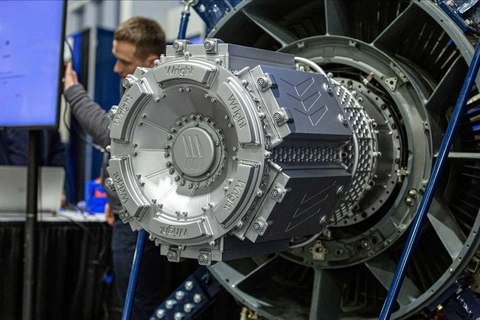ALBANY, N.Y.--(BUSINESS WIRE)--Wright Electric, a world leader in electric propulsion for large commercial aircraft, today announced the launch of its Wright Electric Aircraft Engine Test Cell (WEAETC). The WEAETC is designed to characterize the performance of megawatt-class electric aircraft propulsion systems.
Founded in 2016, Wright’s goal is to decarbonize the aerospace industry. Wright works with leading groups such as NASA, Y Combinator, The US Department of Energy Advanced Research Projects Agency–Energy, and the US Department of Defense.
Wright builds power dense-electric motors and energy-dense batteries for aerospace and defense applications. For example, Wright recently tested its industry-leading electric motor to over 1 megawatt and is planning for altitude testing at the NASA Electric Aircraft Testbed (NEAT). Also, earlier this year, Wright was selected to join the ARPA-E Pioneering Railroad, Oceanic and Plane Electrification with 1K energy storage systems (PROPEL-1K) program, which aims to develop emission-free, high-energy, and high-power energy storage solutions to electrify domestic aircraft, railroads, and ships.
Achieving 1 Megawatt of shaft power is an important step in reaching Wright’s goal of making all single-aisle flights under 800 miles zero emissions. Commercial class airplanes need megawatt-sized propulsion systems for a full passenger load take off.
Through rigorous testing and analysis at the WEAETC, Wright aims to validate the thermal and dynamic stability of Wright's Electric Propulsion Unit (EPU), which is notably quieter than conventional engines. This EPU will be subsequently installed under the wing and flight tested, paving the way for advancements in electrification technologies.
WEAETC will enable testing on fan- and propeller-based propulsion systems. The testing process will unfold in two key phases. Initially, Wright will conduct ground testing utilizing their cutting-edge 2 MW Wright-1A motor. Initial tests will use the LF507-1F fan module and the C-130 propeller. Subsequently, Wright will embark on the second phase, using Wright’s new motor, the WM2500, capable of delivering up to 2.5 MW of power and equipped with an integrated custom drive; this motor has been developed under the ARPA-E ASCEND program.
“Using a proven fan module significantly reduces the risk of the test campaign and lets us directly compare the acoustic profile and thermal signature of the electric propulsion unit and its classical turbofan version,” said Peter Kurowski, Propulsion Lead at Wright. “The successful ground test campaign will open the doors to a flight test.”
Wright’s partners in this effort include ARPA-E, Rzeszow University of Technology, CFS Aero, Avalon Aerospace, and Executive Jet Support.
For more information, please visit: https://www.weflywright.com/
About Wright Electric
Wright Electric Inc. (Wright) is a U.S.-based company working to decarbonize the industries that are hardest to decarbonize. Wright focuses on three main areas: (1) propulsion systems for electric aircraft, (2) lightweight generators for industrial and defense applications, and (3) specialized energy storage solutions for the aerospace and defense industries. The company was founded in 2016 by a team of aerospace engineers, powertrain experts, and battery chemists. Wright works with airlines such as easyJet, and has development contracts with NASA, the Department of Defense, and the U.S. Department of Energy ARPA-E. Wright has been funded through Y Combinator, the Clean Energy Trust, venture funds, and family offices.




